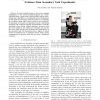152 search results - page 9 / 31 » Developing heuristics for assistive robotics |
ICRA
2010
IEEE
13 years 7 months ago
2010
IEEE
— Powered wheelchairs play a vital role in bringing independence to the severely mobility–impaired. Our robotic wheelchair aims to assist users in driving safely, without under...
NAACL
2003
13 years 10 months ago
2003
We will demonstrate a spoken dialogue interface to a Geologist’s Field Assistant that is being developed as part of NASA’s Mobile Agents project. The assistant consists of a r...
ICRA
1999
IEEE
14 years 26 days ago
1999
IEEE
Service robots which should perform human-like operation will penetrate into a great number of applications in the future. Requirements for this is high flexibility, autonomy and ...
JIRS
2006
13 years 8 months ago
2006
To safely and efficiently guide personnel of search and rescue operations in disaster areas, swift gathering of relevant information such as the locations of victims, must occur. U...
ICRA
2008
IEEE
14 years 3 months ago
2008
IEEE
—A major issue in the field of human-robot interaction for assistance to manipulation is transparency. This basic feature qualifies the capacity for a robot to follow human mov...

